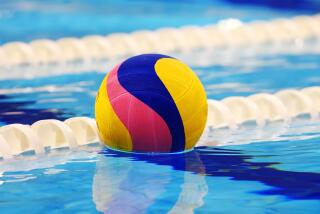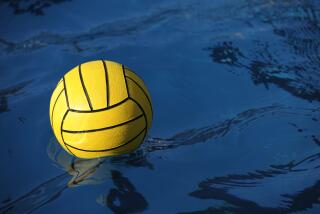SPORTS : Riding Another Wave of Success : Junior Olympic Water Polo Tournament Reaches High-Water Mark in Long Beach
- Share via
Stan Sprague knew there was potential for growth in the mid-1980s when the Amateur Athletic Federation granted a request by U.S. Water Polo to take on responsibility for organizing and managing a Junior Olympic tournament.
Before the switch, water polo had struggled to stay afloat amid more popular sports such as track and field, basketball and swimming, all of which had more participants and influence over the location of Junior Olympic competition sites and schedules.
Today, Junior Olympic water polo is flourishing. Nowhere is that more evident than Long Beach, site of this year’s national tournament, which began Saturday and continues through this weekend.
Sprague is in his ninth year as chairman of the event that has become the largest water polo tournament in the nation. This year, 151 teams are competing in three boys and three girls divisions--13-and-under, 15-and-under and 17-and-under. More than 1,500 players from teams in California, Texas, Florida, Illinois, Missouri, Washington and Maryland began play last week at seven sites.
Semifinal matches will be played today and Friday at Long Beach Wilson High, Los Alamitos High and two pools at Long Beach State. Championship matches in all divisions will be played Saturday at Long Beach State.
“Historically, whenever we have had the tournament in Southern or Northern California, we have always had the largest number of participants,” said Sprague, 53, a Long Beach State graduate who is the goalie coach for the U.S. National team. “This area is simply a hotbed for the sport. That’s evident to anyone who comes out and watches these kids play.”
Long Beach Wilson is among the teams that are considered contenders for championships in this year’s boys tournament, which drew 105 teams. Others include teams based in the Tustin-Anaheim area, Stanford, San Clemente, Corona del Mar, North Hollywood, Clovis, St. Louis and Annapolis, Md.
City of Commerce, Modesto-Stanislaus and Annapolis are considered the strongest girls programs in a 46-team field.
“It used to be that only the top three teams from each region qualified, but the tournament has been opened to anyone who wants to participate,” said Tony Martinho, the boys varsity coach at Los Alamitos High who is serving as the tournament’s local facilities coordinator. “That has allowed more kids to develop and get better.”
Developing players for national-level teams was only one of the goals when U.S. Water Polo took over the Junior Olympic tournament from the AAU. The primary purpose for the switch was to create a well-organized event.
“We were getting a little frustrated because we weren’t getting the numbers of teams participating that we thought we should be getting and we weren’t getting adequate facilities or desk help,” Sprague said. “Water polo was taking a second seat to other sports.”
Not anymore. Martinho said about 150 local volunteers are helping to stage this year’s event, in which every team is guaranteed at least five games.
Those kind of developmental opportunities have become increasingly common for high school-age water polo players. After their regular high school seasons, which might include 25 or 26 matches, players participate in as many as 55 matches during summer leagues and tournaments.
The Junior Olympics allows national team coaches to observe potential international-level players of the future.
“We kind of like to watch the 17-and-unders play because those are the kids we might want to get involved in our national junior team program, which is our progression into the national team,” Sprague said. “When the tournament is here in California, it’s much easier for the coaching staff because we can see all the kids from outside the state in one place.
“It’s nice for us because we’re seeing kids in a competitive environment,” Sprague said. “They don’t know they are being evaluated because it’s done in a very low-key fashion.”
Sprague expects that the National Junior Olympics for water polo will continue to grow.
“It’s only going to get bigger and better,” he said. “And when I say bigger, that doesn’t necessarily mean more teams. We need to keep the numbers up big and the level of competition high.
“I think we’re on the right track.”
More to Read
Go beyond the scoreboard
Get the latest on L.A.'s teams in the daily Sports Report newsletter.
You may occasionally receive promotional content from the Los Angeles Times.







